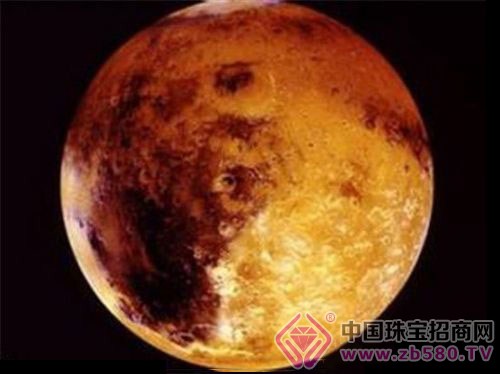
A research team at the University of Glasgow in the United Kingdom identified the fire opal component in a Martian meteorite. The discovery will set the direction for researchers to determine which areas of Mars will be searched for life on Mars in the future. Astronomers believe that there are some "gems" in the depths of Mars, and that they may contain traces of the ancient life of Mars.
Now, for the first time, scientists have found direct evidence on the existence of such "gems" on Mars: scientists found opal in Martian meteorites (Opal in English is Opal, from Latin Opalus, meaning "gems The beauty is in one"). The discovery will set the direction for researchers to determine which areas of Mars will be searched for life on Mars in the future. The discovery of Opal is very exciting, not only because it may contain fossils, but also because the minerals are usually formed near hot springs where microorganisms gather.
The researchers found the mineral in a 1.7-gram sample cut from a piece of Martian meteorite called "Nakhla", which itself was preserved by the Museum of Natural History in London, England. The name Nakhla is named after the small town that fell in Egypt in 1911. Millions of years ago, this piece of Mars was sputtered out of a large comet crash on Mars, leaving Mars and wandering in space.
A research team at the University of Glasgow in the United Kingdom identified "fire opal" in this sample. This opal usually has a bright orange, yellow or red hue. With powerful scanning electron microscopy equipment, the team found a very small amount of opal in this meteorite sample, which is the product of the interaction of liquid water on Mars with the silicate minerals in the rock.
Professor Martin Lee, the first author of the relevant paper, said: "The piece of meteorite we got is very small, and we found fewer opals, but we found that the Opal itself is significant. There are several reasons for this. First, it confirms the imaging and detection results of NASA on the surface of Mars. Previous findings indicate that opal minerals may exist on Mars.
This is the first time this mineral has been found in rocks from Mars. Secondly, we know that on Earth, the minerals of Opal are generally formed near hot springs, and such an environment is where microbes gather and multiply, while opal can wrap and preserve the remains of these microbes for millions of years. time. If the Martian microbes do exist, then it is possible to find the preserved fossil remains in the opal deposits on the surface of Mars. â€
Martin stressed that a more detailed study of Mars opal minerals in future Mars exploration missions will help us learn more about Mars' past history and determine whether it once had life.
The research results are based on the research team's 2013 research results, when the team discovered the first direct evidence that liquid water is present on the Martian surface: the interaction of olivine and pyroxene with water bodies was found in the Nakhla meteorite. Some secondary minerals produced at the time.
Fleece Blankets,Fleece Throw Blanket,Plush Blankets,Sherpa Fleece Blanket
Nantong Yawen Textile CO., LTD , https://www.ntywtextile.com